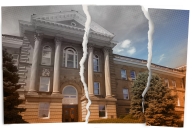You have /5 articles left.
Sign up for a free account or log in.

Getty Images
In a speech last year arguing that higher education faces a crisis in the U.S., Education Secretary Betsy DeVos pointed to eye-popping numbers from the federal student loan program.
Only a quarter of borrowers are making progress paying down their loans, she said, while 20 percent are either delinquent or in default. More than a million borrowers default on their student loans each year, and recent research has suggested the problem is growing worse.
The consequences for those borrowers can be severe, including hits to their credit score and garnishing of federal benefits. Their college may also withhold academic transcripts, and some states will suspend occupational licenses.
While DeVos herself has yet to call for specific changes with defaults in mind, a recent proposal makes the case for Congress to reduce defaults by simply eliminating the loan status outright.
Severely delinquent borrowers could still face negative consequences like credit reporting but would not be cut off from receiving federal student aid to pursue a degree. The idea may sound radical. But it wouldn't include the major costs to the government of large-scale loan forgiveness, argues Colleen Campbell, director for postsecondary education at the Center for American Progress and author of the proposal.
It could also put new scrutiny on whether the tools used to collect the most delinquent loans are truly effective as Congress explores potential changes to loan repayment through an update to the Higher Education Act.
Campbell argues that by ending default, the government could reallocate the $1 billion it spends on debt collections annually to more direct assistance to borrowers when they first start to struggle repaying their loans. Eliminating default would also allow borrowers to keep their access to federal aid like Pell Grants and continue making progress toward a degree.
“The federal government has extraordinary collections mechanisms for student loans that aren’t available for other kinds of consumer debt,” Campbell said. “It’s unnecessary to place additionally punitive consequences on top of collections. So why don’t we remove one of the consequences that is most damaging to folks who have been disenfranchised and who are most likely not benefiting from their experience in the postsecondary system?”
She said federal policy shouldn’t remove tools for struggling borrowers to improve their economic situation, especially opportunities to continue their postsecondary education.
A federal student loan enters default when a borrower has been delinquent for more than 270 days. After that, the loan is reassigned from a loan servicer to a debt collection company.
Ending default status wouldn’t mean removing any tools for the federal government to collect on student loan debt, Campbell said. Severely delinquent borrowers could be automatically enrolled in income-driven repayment plans. And the government could garnish wages and withhold tax refunds for those who still don’t repay their loans.
The government could also much more effectively use the money it spends on collections each year, Campbell said, by paying for better loan servicing.
“We can do much more intensive counseling between servicers and borrowers early on to prevent the worst outcomes,” she said.
Her proposal argues that eliminating default should be accompanied by other legislative changes to the financial aid system such as streamlining repayment programs, simplifying the application for federal student aid, providing more grants to students and creating clearer paths to loan forgiveness. Campbell also calls for assessing loan servicers using more objective measures so that the companies with the best repayment outcomes for borrowers receive new accounts.
Information on defaults is limited. But analyses of recent federal postsecondary data show high rates of default among African American borrowers in particular, even those who completed a degree. Nearly a quarter of black student borrowers who began college in the 2003-04 academic year and earned a bachelor’s degree had defaulted within 12 years.
The federal data also show that defaults depend more on a student’s circumstances and the type of institution they attended than their total amount of debt. Defaults are highest, in fact, among borrowers with the smallest loan amounts. And students who enrolled at for-profit colleges starting in 2003-04 were four times as likely as community college students to have defaulted on their loans 12 years later, according to an analysis by the Brookings Institution.
“This would overwhelmingly help people who don’t finish college, who received a certificate, who are borrowers of color, who are Pell Grant recipients,” Campbell said. “What we know about default is that it overwhelmingly impacts those communities.”
But industry representatives said debt collectors and loan servicers are "as different as apples and oranges."
"There needs to be more help for people who are delinquent," said Shelly Repp, senior adviser and counsel at the National Council of Higher Education Resources. "That doesn’t mean in our view you should get rid of debt collectors once they are in default."
Repp said removing debt collectors from the student loan system also wouldn't save the federal government money, since they only receive payments for loans they collect on.
"That doesn’t mean that more resources can’t be also applied to helping borrowers earlier in the process. As this report points out, compensation to servicer is very low."
Campbell said, however, that collections firms are paid $1,700 for each loan they rehabilitate. And the numbers for those borrowers aren't impressive -- nearly 40 percent of rehabilitated borrowers re-default within three years.
Some financial aid experts say proposals like eliminating default, like efforts in recent years to promote income-driven repayment, wouldn’t actually address whether borrowers are making progress paying down their loan principal. Mark Kantrowitz, publisher and vice president of research for Savingforcollege.com, said student aid policy experts have long questioned whether collection agencies are cost-effective. Many of the most powerful tools used by those companies, he said, could be employed by loan servicers. But he said defining away defaults wouldn’t solve the fundamental issue of loan repayment.
“I do not believe that superficial changes to the name of the problem or slight tweaks to the system will provide a real solution to the underlying problem,” Kantrowitz said. “Unfortunately, policy makers have a tendency to paint a problem a different shade of blue and declare the problem solved.”
But Jessica Thompson, director of policy and planning at the Institute for College Access and Success, said the proposal was an intriguing idea.
“It really does get down to changes that we think are pretty common-sense,” she said.
Thompson said many of the most punitive consequences attached to default aren’t in the interest of the borrower or the taxpayer, because they aren’t effective at getting loans in good standing. Default status for student loans was also created under an entirely different paradigm, when private banks would make loans with backing from the federal government, she said.
The Education Department signaled last year that it was interested in moving away from use of collections firms in the federal student loan program.
And the White House made clear last month that overhauling how defaulted debt is collected remains an ongoing concern for the Trump administration. A broad-ranging executive order on higher ed signed by President Trump included a directive for the Education Department and Treasury Department to recommend reforms of collection on defaulted student debt.
Previous attempts by the Education Department to move away from reliance on debt collectors have been hamstrung by legal challenges. While the executive order could mean more political capital is put behind those efforts, action from Congress could be necessary to move the student loan system away from reliance on debt collectors.
Senate lawmakers are currently discussing a reauthorization of the Higher Education Act for the first time in a decade. Senator Lamar Alexander, the Republican chairman of the Senate education committee, has proposed streamlining loan repayment by having payments automatically deducted from a borrower’s paycheck.
Some researchers have argued that payroll withholding could be the best way to prevent defaults. But Campbell said eliminating default outright would provide benefits to borrowers without overhauling student loan payments in a radical way.
“This isn’t a new repayment plan. It isn’t a complete rejiggering of how people make payments on their loans,” she said. “It’s basically a behind-the-scenes change that ultimately borrowers would experience in a very tangible way.”








